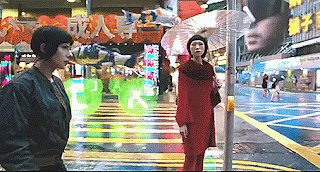That right there is a cool video showing what I’m talking about. It compares some filming locations in Hong Kong with the film. The work they did is astonishing.
While some people might be annoyed by the fact that no characters other than some Japanese background extras and Chief Aramaki seem to speak actual Japanese on-screen, I’m actually not all that bothered by it. The film establishes a possible reason for this at the outset. When the Hanka Robotics rep that gets brain-hacked and the President of the African Federation are having a business meeting, the Hanka rep plays a recording of a child singing in French. It’s his daughter, and he tells the President of the African Federation that in the time that it took his daughter learn Au claire de la lune (a French folk song), she learned the entirety of the French language. Done.
Clearly the daughter has the latest language implant tech, unlike our adult characters who each speak in their respective languages — nonetheless they can still understand each other. Yes, I know; this is a lazy way of not including too many foreign languages in order to, in a business exec’s mind, not to alienate the US audience and so on, but at least it’s supported by the setting itself. And it’s not an something paraded in front of us, either.
Major Mira Killian has fake memories in her brain, implanted by Dr. Ouelet as ‘motivation’ to fight terrorists with Section 9. You see, the story goes that she came into Japan in a refugee boat that was blown up by a terrorist attack. The damage was so bad that she lost almost all of her body. Leaving aside the fact that this revelation that comes near the climax, while a surprise, it’s already substantiated by the poor garbage truck driver that had fake memories hacked into him by Kuze. It should tell us something about the setting that the Major finds it plausible that she came in a refugee boat.
The Japan in the film is more ethnically diverse than today’s Japan; many ethnicities can be seen in the background. There’s a particular shot that shows this best; what better way to convey the changing face of the film’s Japan than by doing a close up of a Black Buddhist? It plays with the stereotype, even though, in the real world there are Buddhists who are black, it’s not what is usually pictured when we hear the word ‘Buddhism’.
 |
| I like the symmetry in the shot, too. |
A lot of cyberpunk works would be set inside of one of this megacorp-run nations, or in another sort of dystopia. Something that has always made the Ghost in the Shell franchise unique is that, in contrast to other works, in future Japan the rule of law still pervades hard, as pointed out in the first confrontation between Cutter and Chief Aramaki — Aramaki immediately dismisses the notion that the Prime Minister would take Cutter’s word over his own. Which makes it extra brilliant, in a way, that the live-action adaptation updates future Japan to be more ethnically diverse, because of course refugees would strive to go to the most stable nation possible in times of strife. It’s kind of a subtle nod to the situation we are living in right now in the world.
That’s not to say there aren’t any shady buisness deals or anything. Major Mira Killian and Batou at some point shoot up some sort of yakuza underground club, not to mention the whole of the unethical experiments tied to Project 2571, the one that resulted in the creation of the Major. There’s also a scene where some shady trafficker, when Batou and the Major are on the way to the marketplace, attempts to sell the Major some black-market body parts or something.
 |
| In general the street scenes are amazing. Look at the background details. |
I told you future Japan was fascinating.
Rosario is an early-twenties, outspoken woman, who likes to burrow between piles of books, and store miscellaneous trivia in her head.













